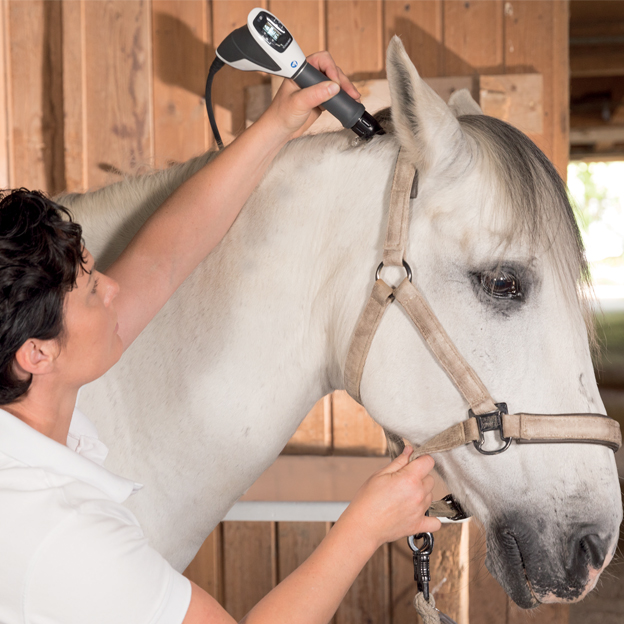Exactly How Laser Therapy in Horse Treatment Is Revolutionizing Vet Take Care Of Horses
Laser treatment has emerged as a transformative strategy in equine veterinary care, providing a non-invasive remedy that quickens recovery and enhances general wellness. The portability and convenience of laser therapy gadgets better underscore their growing necessity among vets.
Understanding Laser Therapy

The modern technology behind laser therapy is grounded in the principle of photochemistry, where photons are soaked up by chromophores within cells, resulting in raised ATP production and inflection of responsive oxygen types (Equine Therapy). This, consequently, promotes mobile proliferation, reduces inflammation, and speeds up healing. Vet experts make use of various sorts of lasers, consisting of low-level lasers (LLLT) and high-power Course IV lasers, relying on the certain healing objectives and the nature of the equine condition being dealt with
Various laser wavelengths and power setups are very carefully chosen to target different tissue depths and achieve wanted professional end results. Safety and security procedures are vital, as incorrect use can cause thermal damage or suboptimal therapeutic results. Hence, a thorough understanding of laser treatment's devices and applications is essential for its effective implementation in equine vet method.
Benefits for Horse Health And Wellness
The myriad advantages of laser treatment for equine health incorporate enhanced recovery, pain reduction, and boosted movement. This innovative treatment technique leverages specific wavelengths of light to permeate cells, promoting cellular function and advertising rapid tissue fixing. The non-invasive nature of laser therapy makes certain minimal stress and anxiety and discomfort for the equine, facilitating a smoother healing procedure.
Improved healing is one of the leading benefits, as laser therapy accelerates cellular regeneration and collagen synthesis. Pain decrease is accomplished via the anti-inflammatory impacts of laser treatment, which lowers swelling and lowers the manufacturing of pain-inducing chemicals.
Improved movement is one more critical benefit, particularly for performance and working horses. By decreasing inflammation and pain, and boosting cells fixing, laser treatment aids in recovering joint feature and muscular tissue adaptability. The cumulative effect of these benefits is not just a quicker go back to regular task however likewise a total improvement in the steed's top quality of life. Therefore, laser therapy stands as a transformative tool in modern horse veterinary care.
Typical Conditions Dealt With
Laser therapy has emerged as a functional therapy option for a range of typical equine problems. Additionally, laser treatment is effective for problems like osteo arthritis, where it assists minimize joint swelling and promote tissue repair.
Wound administration is another location where laser treatment has actually shown substantial assurance. Persistent injuries or slow-healing abscess can be especially tough in horses, yet laser treatment enhances mobile regrowth and enhances blood flow, thus quickening the healing procedure. Moreover, laser therapies have been efficiently employed in managing unguis conditions such as laminitis and abscesses, relieving discomfort and advertising quicker healing.

Modern Technology Behind Laser Therapy
Beyond the myriad conditions treatable with laser therapy, the innovation itself benefits more detailed exam. At the heart of laser therapy is the use of certain wavelengths of light to permeate cells and elicit biological reactions. These wavelengths, generally varying from 600 to 1000 nanometers, are precisely absorbed by chromophores in the skin, muscle, and various other tissues, initiating a cascade of cellular events.
Laser tools used in vet medication usually use low-level laser treatment (LLLT) or cool laser treatment. Unlike high-powered surgical lasers, these tools run at reduced energy find this levels, maximizing therapeutic advantages while reducing thermal damages. The power from the laser light stimulates adenosine triphosphate (ATP) manufacturing, improves cellular metabolic process, and increases tissue fixing procedures.

Success Stories and Situation Researches

Showcasing the concrete advantages of laser therapy, numerous success stories and study brighten its transformative effect on equine wellness. One such situation includes a pureblooded racehorse struggling with chronic tendonitis. Typical treatments yielded marginal renovation, however after incorporating laser treatment into the program, the horse showed considerable decreases in swelling and discomfort within weeks, ultimately returning to affordable auto racing.
One more compelling example includes a dressage steed diagnosed with severe neck and back pain, limiting its efficiency. A vet group used low-level laser treatment (LLLT) to target the inflamed locations, leading to significant improvement in adaptability and a notable reduction in discomfort. Over numerous sessions, the equine regained its peak type, showcasing the efficacy of laser treatment in attending to bone and joint problems.
In addition, a research carried out at a leading equine facility taken a look at right here 50 steeds with different soft cells injuries treated with laser therapy. The outcomes stood out: 85% of the equines showed increased healing times and improved wheelchair. These cases emphasize the versatility and efficiency of laser therapy in equine medicine, using a non-invasive, scientifically-backed strategy to improving healing and performance in horses.
Verdict
Laser therapy is find this changing equine vet care by giving a non-invasive treatment that increases recovery, lowers swelling, and alleviates pain. With its effectiveness in dealing with a series of problems, from bone and joint injuries to persistent conditions like osteoarthritis, this modern technology considerably improves equine wellness and flexibility. The transportability and versatility of laser treatment even more highlight its transformative influence on vet methods, strengthening its function as a crucial device in contemporary equine health care.